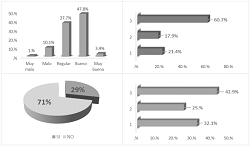Tutoring in the National University of San Martin, Tarapoto, Peru
DOI:
https://doi.org/10.56926/unaaaciencia.v2i2.44Keywords:
student adjustment, academic support, higher education, educational integrationAbstract
The research evaluated the tutoring system at the National University of San Martín, Tarapoto, Peru. A non-experimental approach with a descriptive design was used, with a population of 324 students and 32 teachers, and a sample of 15 teachers and 150 students. Questionnaires were used as instruments. The results revealed that the mentoring process was divided into three stages. The initial tutoring (I and II semester) had a regular perception by the students. The stay tutoring (III to VIII semester) was partially developed, with 53% of respondents rating it as regular. Completion tutoring received a poor rating, with 70% of respondents expressing dissatisfaction. In conclusion, deficiencies were identified in the tutoring system, such as the lack of access to student information, the absence of planning and documentation to support the tutor's performance and the lack of knowledge on the part of both students and tutors about the tutorial action. Despite this, the incorporation and integration of students into the university largely depended on their own efforts. The need to address these deficiencies to improve the system was highlighted.
Downloads
References
Álvarez González, M., & Álvarez Justel, J. (2015). La tutoría universitaria: del modelo actual a un modelo integral. Revista Electrónica Interuniversitaria de Formación Del Profesorado, 18(2), 125. https://doi.org/10.6018/reifop.18.2.219671 DOI: https://doi.org/10.6018/reifop.18.2.219671
Asamblea Universitaria. (2016). Estatuto de la Universidad Nacional de San Martín - Tarapoto. In Resolución N° 005-2016-UNSM/AU-R/NLU. Artículo 54. https://www.transparencia.gob.pe/enlaces/pte_transparencia_enlaces.aspx?id_entidad=10409&id_tema=5&ver=
Benites, R. M. (2020). El papel de la tutoría académica para elevar el rendimiento académico de los estudiantes universitarios. Revista Conrado, 16(77), 315–321. http://scielo.sld.cu/scielo.php?pid=S1990-86442020000600315&script=sci_arttext&tlng=en
Castro Cuesta, R. A. (2014). Análisis de las buenas prácticas del tutor universitario: estudio de caso en la Universidad Tecnológica de Chihuahua de México [Universidad Autónoma de Barcelona]. http://hdl.handle.net/10803/133264
Castro, F., Durán, E., & Urbieta, E. (2018). Inducción E Integración A La Vida Universitaria. Congresos CLABES. https://revistas.utp.ac.pa/index.php/clabes/article/view/2022
Ferreyra, M. M. (2017). Momento decisivo: la educación superior en América Latina y el Caribe. Education for Global Development. https://blogs.worldbank.org/es/education/momento-decisivo-la-educaci-n-superior-en-am-rica-latina-y-el-caribe
Figuera Gazo, P. (2015). Persistir con éxito en la universidad: De la investigación a la acción (1st ed.). Laertes editorial, S.L.
García, J. L. A. (2019). La tutoría universitaria como práctica docente: fundamentos y métodos para el desarrollo de planes de acción tutorial en la universidad. Pro-Posições, 30. https://doi.org/10.1590/1980-6248-2017-0038 DOI: https://doi.org/10.1590/1980-6248-2017-0038
López Gómez, E. (2015). La tutoría en el EEES: propuesta, validación y valoración de un modelo integral. Ediciones Universidad de Salamanca, 33, 235. https://go.gale.com/ps/i.do?id=GALE%7CA448568718&sid=googleScholar&v=2.1&it=r&linkaccess=fulltext&issn=02125374&p=IFME&sw=w&userGroupName=anon~3ab578f9&aty=open-web-entry
Mariscal González, S. L. (2013). La integracion social de los estudiantes a la vidauniversitaria en su primer año. In Los estudiantes y la universidad: Integración, Experiencias e Identidades (1st ed., p. 334). Anuies, Dirección de Medios Editoriales.
Merino Orozco, A., Berbegal Vázquez, A., Saez Velasco, S., & González García, J. (2023). El acompañamiento para la proyección académico-profesional desde la tutoría universitaria: un análisis cualitativo desde la mirada docente. Debate Universitario, 13(22), 9–24. https://doi.org/10.59471/debate202343 DOI: https://doi.org/10.59471/debate202343
Narro, J., & Arredondo, M. (2013). La tutoría como proceso fundamental en la formación de estudiantes universitarios. Perfiles Educativos, 35(141), 132–151. https://n9.cl/bm8s9 DOI: https://doi.org/10.22201/iisue.24486167e.2013.141.40528
Pérez-Serrano, M. J., Rodríguez-Pallares, M., & González-Alonso, M. Y. (2020). Utilidad de las tutorías académicas en la universidad. Revista de Ciencias de La Comunicación e Información, 57–74. https://doi.org/10.35742/rcci.2020.25(1).57-74 DOI: https://doi.org/10.35742/rcci.2020.25(1).57-74
Perosa, G., Benítez Molina, P. I., & Jarpa Sandoval, B. M. (2021). Trayectorias educativas en América Latina y el Caribe en el Siglo XXI. Foro de Educación, 19(2), 45–68. https://doi.org/10.14516/fde.888 DOI: https://doi.org/10.14516/fde.888
Saavedra Villacrez, W. (2016). Propuesta de un sistema de tutoría universitario [Universidad Nacional de Trujillo]. http://dspace.unitru.edu.pe/handle/UNITRU/7769
Tuero Herrero, E., Cervero, A., Esteban, M., & Bernardo, A. (2018). ¿Por qué abandonan los alumnos universitarios? Variables de influencia en el planteamiento y consolidación del abandono. Educación XX1, 21(2). https://doi.org/10.5944/educxx1.20066 DOI: https://doi.org/10.5944/educxx1.20066
Yapu, M., Apaza, E., & Xavier, F. (2021). Jóvenes universitarios, nuevas tecnologías y desigualdad. Ciencia y Cultura, 25(46), 11–38. http://www.scielo.org.bo/scielo.php?pid=S2077-33232021000100002&script=sci_abstract&tlng=pt

Published
How to Cite
Issue
Section
License
Copyright (c) 2023 Juan Carlos García-Castro, Wilson Torres-Delgado, Ángel Cárdenas-García, Mariano Chávez-Bazán

This work is licensed under a Creative Commons Attribution 4.0 International License.
The authors retain their rights:
a. The authors retain their trademark and patent rights, as well as any process or procedure described in the article.
b. The authors retain the right to share, copy, distribute, execute and publicly communicate the article published in the scientific journal UNAAACIENCIA-PERÚ (for example, place it in an institutional repository or publish it in a book), with an acknowledgment of its initial publication in UNAAACIENCIA-PERU.
c. Authors retain the right to make a subsequent publication of their work, to use the article or any part of it (for example: a compilation of their works, notes for conferences, thesis, or for a book), provided that they indicate the source. of publication (authors of the work, magazine, volume, number and date).







